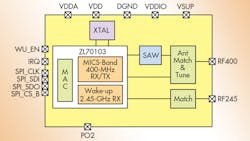RF Module Cures Medical Design Woes
A miniature wireless radio module has been developed specifically for implantable medical devices such as pacemakers, cardiac defibrillators and neurostimulators. The model ZL70323 module measures just 5.5 × 4.5 × 1.5 mm and complements the firm’s ZL70120 module at the other side of the communications link. The module employs a low-power transmitter and receiver operating in the Medical Implantable Communications Service (MICS) band at 402 to 405 MHz, along with a 24-MHz crystal reference oscillator and surface-acoustic-wave (SAW) filters. It includes a “wake-up” receiver at 2.45-GHz which can be used as needed. The module communications health status data and, with its small size, can be implanted with only extremely small incisions required.
Microsemi Corp., One Enterprise, Aliso Viejo, CA 92656; (800) 713-4113, (949) 380-6100
About the Author
Jack Browne
Technical Contributor
Jack Browne, Technical Contributor, has worked in technical publishing for over 30 years. He managed the content and production of three technical journals while at the American Institute of Physics, including Medical Physics and the Journal of Vacuum Science & Technology. He has been a Publisher and Editor for Penton Media, started the firm’s Wireless Symposium & Exhibition trade show in 1993, and currently serves as Technical Contributor for that company's Microwaves & RF magazine. Browne, who holds a BS in Mathematics from City College of New York and BA degrees in English and Philosophy from Fordham University, is a member of the IEEE.
